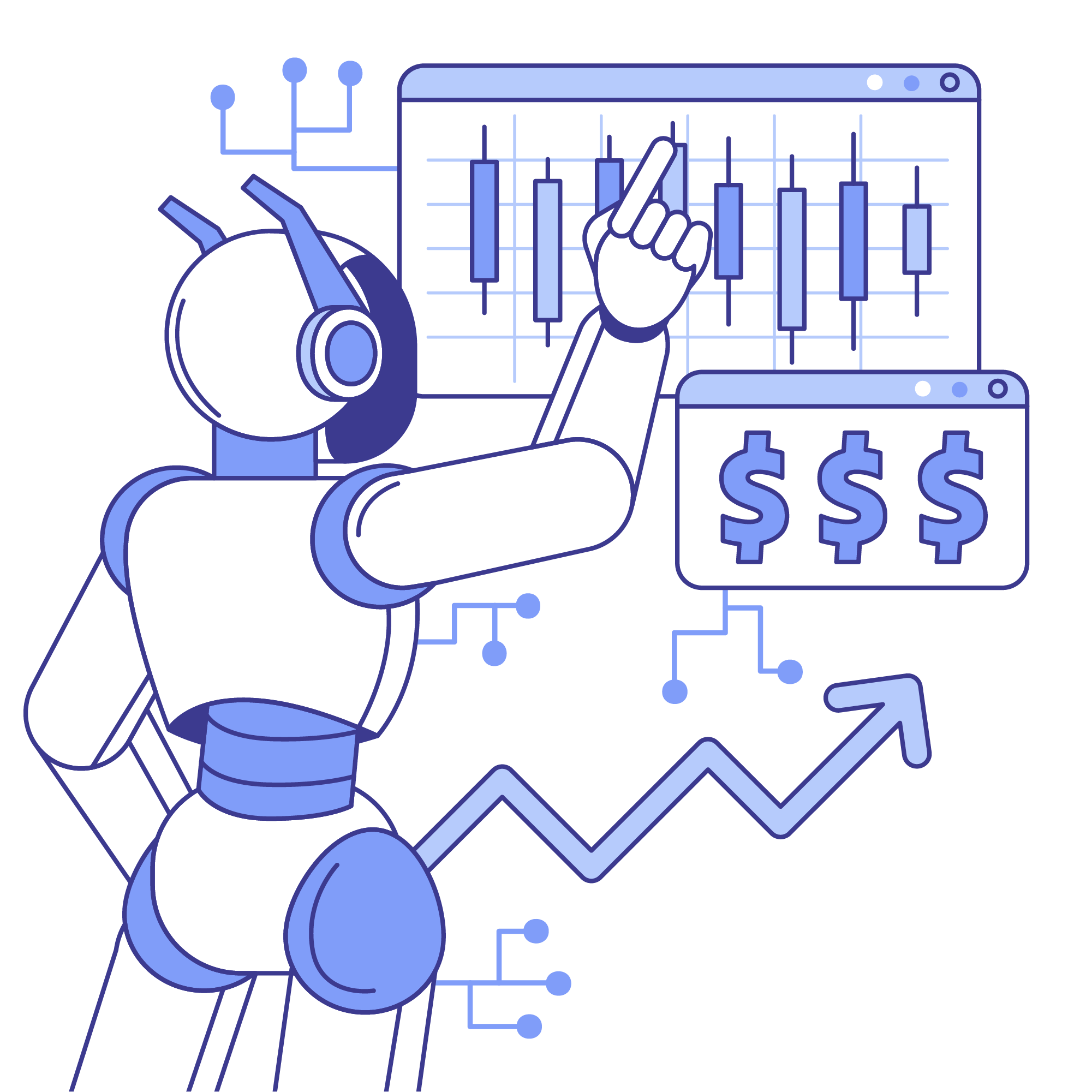What Is an AI SDR? Understanding the Meaning and Impact
An AI SDR or AI sales development representative is a tool that uses AI to automate tasks handled by human SDRs, like lead generation, outreach, and more.

An AI SDR (Artificial Intelligence Sales Development Representative) is an automation tool that uses AI to streamline tasks traditionally handled by human SDRs—the solution that scales your outreach effortlessly, engages prospects with hyper-personalization and operates 24/7 without the hefty overhead.
No burnout, no missed opportunities, just efficient, data-driven sales development.
Let’s dive deeper into this.
What is an AI SDR?
An AI SDR, or AI Sales Development Representative, is a tool that uses artificial intelligence in different ways within sales teams.
We can have them managing the entire lead generating process or delegate specific manual tasks in sales, allowing human SDRs to focus on more critical aspects.
The extent to which you incorporate AI SDRs into your workflows depends on your tech comfort level and the complexity of your existing setup.

In the upcoming sections, we’ll provide all the insights you need to decide the best approach for integrating AI SDRs into your business.
Difference between AI vs Human SDRs:
Are you worried about adding AI to your team? It's normal to have questions such as, "How does AI compare to human employees?"
It's essential to compare their strengths and weaknesses with those of human SDRs. Both play crucial roles in the sales development process, but they offer different advantages.
So, let's break it down and explore the differences and benefits of each.
Feature | AI SDRs | Human SDRs |
Scalability | Handles thousands of leads simultaneously. | Limited by time and capacity. |
Response Time | Instant, 24/7 availability. | Limited by work hours, slower response. |
Personalization | Data-driven hyper-personalization. | Relies on intuition and relationship building. |
Cost Efficiency | No salaries or ongoing costs. | Higher costs for salaries and training. |
Emotional Intelligence | Lacks deep emotional understanding. | Strong in empathy and social cues. |
Learning Curve | Learns from data, no formal training needed. | Requires continuous training and support. |
Adaptability | Adapts to data but struggles with nuances. | Flexible in real-time, handles complex situations. |
By combining AI SDRs with human SDRs, businesses can maximize productivity, allowing AI to manage repetitive tasks while human SDRs focus on relationship-building and closing deals.
Read more: Do You Need to Choose Between AI and Human SDRs?
Here are some key reasons why businesses are increasingly turning to AI-driven solutions to boost their sales efficiency and results.
Why should businesses implement AI SDRs?
Adopting AI-driven Sales Development Representatives (SDRs) offers organizations a strategic edge by enhancing the efficiency and effectiveness of sales operations. Here are some key reasons why AI SDRs are becoming an essential part of modern sales teams:
- Automated Prospecting and Lead Generation
AI SDRs automate lead identification and engagement by analyzing large datasets and sending personalized messages, helping sales teams focus on high-potential leads.
- Identifies and engages potential leads automatically.
- Analyzes large datasets to find ideal prospects.
- Sends personalized messages at scale.
- Improves conversion rates by targeting the right leads.
- Data-Driven Insights and Actions
AI SDRs use advanced analytics to interpret lead behavior and sales data, providing actionable insights that help refine strategies and target valuable prospects.
- Analyzes lead behavior, interactions, and sales data.
- Identifies trends and patterns.
- Provides actionable insights for smarter decisions.
- Helps optimize sales strategies effectively.
- Consistent Prospect Experience
AI SDRs ensure every lead receives the same level of attention by maintaining consistent messaging, tone, and timing, fostering trust and strengthening relationships.
- Delivers uniform attention and follow-ups.
- Maintains consistent tone and messaging.
- Eliminates performance inconsistencies.
- Builds stronger customer relationships.
- Enhanced Outbound Sales Efficiency
By automating time-consuming outbound tasks, AI SDRs allow sales teams to focus on nurturing relationships and closing deals, boosting overall efficiency.
- Automates lead research and initial outreach.
- Frees sales teams for relationship-building.
- Expands outreach volume without added resources.
- Improves chances of winning new business.
- Acquire more time for humans
Integrating AI SDRs into the lead generation tech stack allows marketing and sales teams to reclaim valuable time for strategic tasks that demand human creativity and problem-solving.
With more time on their hands, teams can:
- Refine sales pitches and ICP marketing tactics to improve objection handling.
- Build stronger relationships with high-value prospects by focusing on trust and rapport.
- Prioritize must-win accounts for more targeted and effective outreach.
- Ensure seamless handoffs and account alignment between sales and marketing.
- Invest in B2B sales research to better understand prospects and ideal customer profiles.
The outcome? More impactful sales and marketing teams that drive success through enhanced efficiency, deeper personalization, and greater scalability.

How do AI SDRs work?
To fully understand the meaning of AI SDR, diving into the technology that powers it is essential. Machine learning and (NLP) Natural Language Processing are at the heart of an AI SDR, which allows the AI to process large amounts of data, make decisions, and engage in conversations.
- Machine Learning: This technology allows AI SDRs to continuously improve by learning from past interactions. The AI can analyze data on previous conversations, lead behavior, and outcomes to optimize future engagements.
- Natural Language Processing (NLP): NLP enables the AI to understand, interpret, and generate human language. This technology allows AI SDRs to hold conversations with prospects, respond to inquiries, and handle objections with a sophistication that mimics human interaction.
Together, these technologies allow AI SDRs to perform at a level that can rival and sometimes surpass human SDRs. Whether engaging with a prospect through a personalized message or qualifying a lead based on data, AI SDRs like Alisha can handle these tasks with precision and speed.
The Top 6 AI SDRs
These AI SDR platforms are designed to streamline sales processes, automate lead outreach, and improve engagement rates. Here's a list of the top AI SDRs making waves in the industry:
1. Alisha by Floworks
Floworks' flagship product, Alisha, is a powerful AI SDR that automates sales outreach, personalized follow-ups, and CRM management. Alisha creates hyper-personalized emails and handles complex CRM tasks at scale. Alisha improves efficiency, reduces overhead costs, and ensures sales teams don't lose out on valuable leads, helping businesses grow with less manual effort.
Key features:
- Hyper-Personalized Outreach: Alisha crafts tailored emails based on data analysis, increasing the likelihood of engagement and response.
- Automated Follow-Ups: Continuous engagement with prospects through personalized and timely follow-ups to ensure no lead slips through the cracks.
- CRM Integration: Seamless sync with CRM platforms like HubSpot, ensuring data hygiene and accurate lead tracking.
- Lead Qualification: Automatically qualifies leads by analyzing responses and behavior, ensuring sales teams focus on high-potential prospects.
- 24/7 Availability: Alisha works around the clock, ensuring prospects are always engaged regardless of time zone.
2. Ava by Artisan
Ava is an intelligent AI SDR that specializes in managing prospecting and lead engagement. With its strong focus on personalization, Ava ensures that outreach isn't just automated, but resonates with prospects individually. Ava streamlines lead qualification, follow-ups, and nurturing, allowing sales teams to focus on closing deals rather than chasing after leads.
Key features:
- Personalized Messaging: Ava uses advanced AI to craft highly customized emails, ensuring relevance and higher conversion rates.
- Automated Lead Engagement: Ava handles lead engagement from initial contact through follow-ups, reducing the workload for sales teams.
- Lead Scoring: Ava scores leads based on engagement data, prioritizing the highest potential prospects.
3. AISDR
AiSDR is an AI-powered sales development representative designed to automate and enhance sales outreach. It engages in personalized conversations via text and email, leveraging prospects' LinkedIn activity and HubSpot data to book meetings with ideal clients.
Key Features:
- Personalized Outreach: Analyzes a lead’s recent LinkedIn posts to craft tailored messages that capture attention and make compelling pitches.
- Automated Follow-Ups: Sends timely, context-aware follow-ups, addresses inquiries, manages referrals, and handles auto-replies, ensuring continuous engagement with prospects.
- CRM Integration: Seamlessly integrates with HubSpot through a native two-way sync, enrolling new leads into campaigns based on their sales journey and intent level.
- Lead Generation: Accesses a database of over 700 million contacts to identify prospects matching your Ideal Customer Profile (ICP), utilizing qualification criteria along with hiring and buying intent data.
4. Piper by Qualified
Piper specializes in engaging website visitors through AI-powered conversations. By identifying high-quality leads early in their journey, Piper can trigger automated outreach and follow-ups, dramatically increasing the chance of conversion. Piper integrates with CRM systems to ensure sales reps have a clear view of prospects' interactions and behaviors, making it a powerful tool for engaging and converting leads quickly.
Key features:
- Real-Time Website Engagement: Piper engages website visitors with AI-powered chatbots, qualifying them and providing instant answers to their questions.
- Automated Outreach: Once a lead is identified, Piper automates follow-up outreach, maintaining consistent communication without human intervention.
- Lead Scoring and Prioritization: Piper uses AI to score leads based on behavior and engagement, enabling sales teams to prioritize high-value prospects.
- Customizable Workflows: Sales teams can customize the workflows based on their unique needs, optimizing Piper for their specific sales process.
5. Alice by 11x
Alice is an AI SDR designed to supercharge lead generation efforts with deep learning algorithms. Its strength lies in its ability to automatically personalize outreach at scale while maintaining high levels of engagement. Alice uses predictive analytics to determine which leads are most likely to convert, ensuring sales reps focus their efforts on the right prospects.
Key features:
- Predictive Analytics: Alice uses machine learning to predict which leads will most likely convert, optimizing outreach strategies and improving conversions.
- Automated Personalization: Alice crafts personalized messages at scale, ensuring high engagement without sacrificing the quality of outreach.
- Behavior Tracking: Alice tracks lead behavior across multiple channels, allowing the AI to adjust communication strategies accordingly.
Once you've identified the right AI SDR tool for your business, integrating it into your existing sales workflows is essential for maximizing its impact. Here's how AI SDRs can seamlessly integrate with your current processes to drive efficiency and improve results.
6. Bosh by Relevance
Bosh is an AI-powered sales assistant that automates outreach and prospect engagement. It is designed to work with businesses of all sizes, offering personalized communication to potential customers. Its AI algorithms help generate and maintain the best leads by ensuring they receive tailored messaging at the right time. Bosh optimizes lead qualification, making sales teams more efficient and effective.
Key features:
- Intelligent Outreach: Bosh uses AI to send personalized, timely messages that engage leads effectively.
- Behavioral Insights: The platform tracks lead interactions and adjusts its outreach strategy accordingly, ensuring each message resonates with the prospect.
- CRM Sync: Bosh integrates with CRM systems to record and track all lead interactions for easy follow-up and reporting.
Integration of AI SDR with Sales Workflows
This integration ensures that businesses maintain a steady flow of leads and build stronger, more meaningful relationships with potential customers. Here's how AI SDRs fit perfectly into various aspects of the sales process.
1. Lead Generation and Prospecting
AI SDRs excel at generating leads through various channels, including emails, social media, and website interactions. By automating prospecting, AI SDR can reach out to thousands of potential leads at once, analyzing their behavior and engagement patterns to identify the most promising ones.
2. Personalizing Communication
AI SDR crafts individualized emails, calls, and messages by analyzing customer data, including previous interactions, preferences, and behaviors. This level of personalization enhances engagement and increases the likelihood of conversion. As the AI SDR automates outreach, sales teams can focus on refining strategies and deepening relationships with the most engaged prospects.
3. Automating Follow-ups
AI SDRs can automate follow-up emails, reminders, and meeting scheduling, ensuring leads remain engaged throughout their buying journey. With AI automation, follow-ups are timely, personalized, and consistent, which helps keep potential customers in the pipeline without overwhelming the sales team with administrative tasks.
4. Lead Scoring and Qualification
By analyzing a lead's behavior, engagement, and interactions, AI SDRs can score and prioritize leads based on their likelihood to convert. This integration ensures that sales reps always work with the highest-value leads and don't waste time on low-priority prospects.
5. Real-time Insights and Analytics
By integrating with sales platforms and CRMs, these tools generate detailed reports on how well outreach efforts are performing, which messaging resonates best with prospects, and what strategies drive the most conversions. Sales teams can use these insights to optimize their workflow, adjust their approach, and make informed decisions that boost their success.
6. Enhancing Collaboration Between Sales and Marketing
When sales teams use AI SDRs, they can pass on insights to marketing, such as what content or messaging worked best for specific segments. Conversely, marketing teams can better understand which leads require additional nurturing or specific resources. This collaboration ensures that both teams are aligned and that the sales pipeline remains efficient and effective.
7. CRM Integration for Seamless Workflow
Most AI SDRs are designed to integrate directly with existing CRM systems like Salesforce, HubSpot, and Zoho. This ensures that data flows smoothly between the AI tool and the CRM without manual updates. As the AI SDR gathers data and interacts with leads, it automatically updates CRM records, allowing sales teams to track engagement and manage leads without juggling multiple platforms.
8. Scaling Outreach Efforts
While a human sales rep may only be able to manage a limited number of leads, an AI SDR can handle thousands of prospects simultaneously. By automating many repetitive tasks involved in outreach, qualification, and follow-ups, sales teams can reach more prospects without increasing headcount or sacrificing effectiveness.
With the advancements in AI technology, the future of AI SDRs is bright. Let's take a closer look at what the future holds for AI SDRs.
Know more about what sales automation is and how an AI SDR automates. Read: What Is Sales Automation: A Complete Guide to Strategies and Tools
Future of AI SDRs
The future of AI SDR looks promising as it continues to evolve and adapt to various business needs. Here are some key trends:
- Increased Adoption: AI SDR is becoming a critical tool for businesses, with 77% of companies either using or exploring AI technologies in their operations. This indicates a strong trend toward integrating AI into sales and customer engagement strategies.
- Market Growth: The global AI market is projected to grow significantly, with estimates suggesting it could contribute approximately $15.7 trillion to the global economy by 2030, highlighting the economic impact of AI technologies like AI SDR.
The future of AI SDR is characterized by widespread adoption, enhanced capabilities for personalization and efficiency, and a significant contribution to economic growth.
Conclusion
AI-driven Sales Development Representatives (SDRs) are transforming the way businesses approach lead generation, prospecting, and sales engagement. AI SDRs are streamlining workflows, enhancing efficiency, and improving sales outcomes by automating repetitive tasks and providing real-time, data-driven insights.
As AI technology advances, businesses adopting these tools will have a competitive edge, enabling them to scale sales efforts without needing additional headcount.
Looking for a seamless way to optimize your sales processes? Floworks’ AI-powered solution, Alisha, is designed to automate critical sales tasks, from lead generation to follow-ups, while integrating directly with your CRM. This ensures no leads slip through, allowing your team to focus on closing deals.
Reach out to us today for a personalized demo!
FAQs
Will AI replace SDRs?
AI won't completely replace SDRs but can handle repetitive tasks like outreach AI-powered SDRs won’t completely replace human SDR teams but will transform the sales process by automating repetitive tasks like email outreach, outbound prospecting, follow-ups, and lead qualification. This allows SDR teams to focus on hyper-personalized outreach, relationship-building, and closing more deals. AI seamlessly integrates with sales tools to increase pipeline efficiency, proving its value in boosting the number of meetings booked and overall revenue generation. AI SDRs act as an extension of your sales team, not a replacement.
How can AI help/improve sales performance?
AI SDRs improve sales performance by optimizing the sales cycle—automating lead data analysis, personalizing cold emails at scale, and prioritizing high-value prospects. AI-driven insights ensure SDR teams focus on the best leads, increasing conversion rates and inbound leads. AI-powered SDR tools help sales teams book more meetings, reduce manual tasks, and streamline follow-ups, leading to higher sales volume and predictable revenue.
How to use AI as a sales rep?
An AI agent can act as a virtual SDR, handling outreach, qualifying prospects, scheduling meetings, and automating follow-up messages. AI-driven software ensures SDR teams send hyper-personalized outreach at scale, increasing the efficiency of both inbound and outbound prospecting. AI SDRs help sales reps control their pipeline, match prospects with the right solutions, and ultimately sell more by focusing on the highest-value leads.
What role can AI tools play in the post-sales phase specifically?
AI tools can assist with follow-ups, customer satisfaction surveys, and identifying upsell opportunities. AI can recommend personalized post-sales strategies to enhance customer retention and loyalty by interpreting customer behavior and feedback.
What is one way in which AI technology improves sales prospecting?
AI improves sales prospecting by analyzing vast amounts of data to determine the most promising leads. It can predict which prospects are more likely to convert, helping SDRs with strategic insights to focus on high-quality leads and improving efficiency and outcomes.


